Research Trends, Hotspots and Frontiers of Ozone Pollution from 1996 to 2021: A Review Based on a Bibliometric Visualization Analysis
Abstract
:1. Introduction
2. Data Collection and Analytical Methods
2.1. CiteSpace Software
2.2. Software Settings
2.3. Statistical Analysis
3. Results
3.1. Analysis of Publication Outputs
3.2. Analysis of Countries, Institutions, Research Fields, Authors, and Journals
3.3. Collaborating Network Analysis of Countries, Institutions, and Authors
3.4. Co-Occurrence Keyword Network Analyses
3.5. Co-Cited Reference Analysis
4. Discussion
4.1. General Information
4.2. Intellectual Base and Research Status
4.3. Research Topic Evolution and Tendency
4.4. Research Hotspots and Frontiers
4.5. Limitations
5. Conclusions
Author Contributions
Funding
Institutional Review Board Statement
Informed Consent Statement
Data Availability Statement
Conflicts of Interest
References
- Fioletov, V.E. Ozone climatology, trends, and substances that control ozone. Atmos. Ocean 2008, 46, 39–67. [Google Scholar] [CrossRef]
- Liang, Q.; Rodriguez, J.M.; Douglass, A.R.; Crawford, J.H.; Olson, J.R.; Apel, E.; Bian, H.; Blake, D.R.; Brune, W.; Chin, M.; et al. Reactive nitrogen, ozone and ozone production in the Arctic troposphere and the impact of stratosphere-troposphere exchange. Atmos. Chem. Phys. 2011, 11, 13181–13199. [Google Scholar] [CrossRef]
- Anenberg, S.C.; Schwartz, J.; Shindell, D.; Amann, M.; Faluvegi, G.; Klimont, Z.; Janssens-Maenhout, G.; Pozzoli, L.; Van Dingenen, R.; Vignati, E.; et al. Global air quality and health co-benefits of mitigating near-term climate change through methane and black carbon emission controls. Environ. Health Perspect. 2012, 120, 831–839. [Google Scholar] [CrossRef] [PubMed]
- Tai, A.P.K.; Martin, M.V.; Heald, C.L. Threat to future global food security from climate change and ozone air pollution. Nat. Clim. Chang. 2014, 4, 817–821. [Google Scholar] [CrossRef]
- Yue, X.; Unger, N.; Harper, K.; Xia, X.; Liao, H.; Zhu, T.; Xiao, J.; Feng, Z.; Li, J. Ozone and haze pollution weakens net primary productivity in China. Atmos. Chem. Phys. 2017, 17, 6073–6089. [Google Scholar] [CrossRef]
- Paoletti, E.; Grulke, N.E. Ozone exposure and stomatal sluggishness in different plant physiognomic classes. Environ. Pollut. 2010, 158, 2664–2671. [Google Scholar] [CrossRef]
- Gangoiti, G.; Millán, M.; Salvador, R.; Mantilla, E. Long-range transport and re-circulation of pollutants in the western Mediterranean during the project Regional Cycles of Air Pollution in the West-Central Mediterranean Area. Atmos. Environ. 2001, 35, 6267–6276. [Google Scholar] [CrossRef]
- Kinney, P.L. The pulmonary effects of outdoor ozone and particle air pollution. Semin. Respir. Crit. Care Med. 1999, 20, 601–607. [Google Scholar] [CrossRef]
- Chen, T.M.; Gokhale, J.; Shofer, S.; Kuschner, W.G. Outdoor air pollution: Ozone health effects. Am. J. Med. Sci. 2007, 333, 244–248. [Google Scholar] [CrossRef]
- Monks, P.S.; Archibald, A.T.; Colette, A.; Cooper, O.; Coyle, M.; Derwent, R.; Fowler, D.; Granier, C.; Law, K.S.; Mills, G.E.; et al. Tropospheric ozone and its precursors from the urban to the global scale from air quality to short-lived climate forcer. Atmos. Chem. Phys. 2015, 15, 8889–8973. [Google Scholar] [CrossRef] [Green Version]
- Karnosky, D.F.; Skelly, J.M.; Percy, K.E.; Chappelka, A.H. Perspectives regarding 50 years of research on effects of tropospheric ozone air pollution on US forests. Environ. Pollut. 2007, 147, 489–506. [Google Scholar] [CrossRef] [PubMed]
- Sicard, P. Ground-level ozone over time: An observation-based global overview. Curr. Opin. Environ. Sci. Health 2021, 19, 100226. [Google Scholar] [CrossRef]
- Chen, C.; Song, M. Visualizing a field of research: A methodology of systematic scientometric reviews. PLoS ONE 2019, 14, e0223994. [Google Scholar] [CrossRef] [PubMed]
- Chen, C. A Glimpse of the First Eight Months of the COVID-19 Literature on Microsoft Academic Graph: Themes, Citation Contexts, and Uncertainties. Front. Res. Metr. Anal. 2020, 5, 607286. [Google Scholar] [CrossRef] [PubMed]
- Massey, P.M.; Kim, M.C.; Dalrymple, P.W.; Rogers, M.L.; Hawthorne, K.H.; Manganello, J.A. Visualizing Patterns and Trends of 25 Years of Published Health Literacy Research. Health Lit. Res. Pract. 2017, 1, e182–e191. [Google Scholar] [CrossRef]
- Wang, L.; Xia, E.; Li, H.; Wang, W. A Bibliometric Analysis of Crowdsourcing in the Field of Public Health. Int. J. Environ. Res. Public Health 2019, 16, 3825. [Google Scholar] [CrossRef]
- Liang, C.; Luo, A.; Zhong, Z. Knowledge mapping of medication literacy study: A visualized analysis using CiteSpace. SAGE Open Med. 2018, 6, 2050312118800199. [Google Scholar] [CrossRef]
- Chen, C. CiteSpace II: Detecting and visualizing emerging trends and transient patterns in scientific literature. J. Am. Soc. Inf. Sci. Technol. 2006, 57, 359–377. [Google Scholar] [CrossRef]
- Liu, S.; Sun, Y.P.; Gao, X.L.; Sui, Y. Knowledge domain and emerging trends in Alzheimer’s disease: A scientometric review based on CiteSpace analysis. Neural Regen. Res. 2019, 14, 1643–1650. [Google Scholar] [CrossRef]
- Ho, Y.S.; Satoh, H.; Lin, S.Y. Japanese Lung Cancer Research Trends and Performance in Science Citation Index. Intern. Med. 2010, 49, 2219–2228. [Google Scholar] [CrossRef] [Green Version]
- Ye, N.; Kueh, T.-B.; Hou, L.; Liu, Y.; Yu, H. A Bibliometric Analysis of Corporate Social Responsibility in Sustainable Development. J. Clean. Prod. 2020, 272, 122679. [Google Scholar] [CrossRef]
- Niu, L.; Zhao, X.; Wu, F.; Tang, Z.; Lv, H.; Wang, J.; Fang, M.; Giesy, J.P. Hotpots and trends of covalent organic frameworks (COFs) in the environmental and energy field: Bibliometric analysis. Sci. Total. Environ. 2021, 783, 146838. [Google Scholar] [CrossRef] [PubMed]
- Xu, X. Recent advances in studies of ozone pollution and impacts in China: A short review. Curr. Opin. Environ. Sci. Health 2021, 19, 100225. [Google Scholar] [CrossRef]
- Levelt, P.F.; van den Oord, G.H.J.; Dobber, M.R.; Malkki, A.; Huib, V.; de, V.; Stammes, P.J.; Lundell, J.O.V.; Saari, H. The ozone monitoring instrument. IEEE Trans. Geosci. Remote Sens. 2006, 44, 1093–1101. [Google Scholar] [CrossRef]
- Jerrett, M.; Burnett, R.T.; Pope, C.A.; Ito, K.; Thurston, G.; Krewski, D.; Shi, Y.L.; Calle, E.; Thun, M. Long-Term Ozone Exposure and Mortality. N. Engl. J. Med. 2009, 360, 1085–1095. [Google Scholar] [CrossRef]
- Bell, M.L.; McDermott, A.; Zeger, S.L.; Samet, J.M.; Dominici, F. Ozone and Short-term Mortality in 95 US Urban Communities, 1987–2000. Am. Med. Assoc. 2004, 292, 2372–2378. [Google Scholar] [CrossRef]
- Li, K.; Jacob, D.J.; Liao, H.; Shen, L.; Zhang, Q.; Bates, K.H. Anthropogenic drivers of 2013-2017 trends in summer surface ozone in China. Proc. Natl. Acad. Sci. USA 2019, 116, 422–427. [Google Scholar] [CrossRef]
- Brook, R.D.; Brook, J.R.; Urch, B.; Vincent, R.; Rajagopalan, S.; Silverman, F. Inhalation of fine particulate air pollution and ozone causes acute arterial vasoconstriction in healthy adults. Circulation 2002, 105, 1534–1536. [Google Scholar] [CrossRef] [PubMed]
- McConnell, R.; Berhane, K.; Gilliland, F.; London, S.J.; Islam, T.; Gauderman, W.J.; Avol, E.; Margolis, H.G.; Peters, J.M. Asthma in exercising children exposed to ozone: A cohort study. Lancet 2002, 359, 386–391. [Google Scholar] [CrossRef]
- Anenberg, S.C.; Horowitz, L.W.; Tong, D.Q.; West, J.J. An estimate of the global burden of anthropogenic ozone and fine particulate matter on premature human mortality using atmospheric modeling. Environ. Health Perspect. 2010, 118, 1189–1195. [Google Scholar] [CrossRef] [Green Version]
- Bell, M.L.; Dominici, F.; Samet, J.M. A meta-analysis of time-series studies of ozone and mortality with comparison to the national morbidity, mortality, and air pollution study. Epidemiology 2005, 16, 436–445. [Google Scholar] [CrossRef] [PubMed]
- Fann, N.; Lamson, A.D.; Anenberg, S.C.; Wesson, K.; Risley, D.; Hubbell, B.J. Estimating the national public health burden associated with exposure to ambient PM2.5 and ozone. Risk Anal. 2012, 32, 81–95. [Google Scholar] [CrossRef]
- Richard, G.; Derwent, M.E.J.; Saunders, S.M.; Pilling, M.J. Photochemical ozone creation potentials for organic compounds in northwest Europe calculated with a master chemical mechanism. Atmos. Environ. 1998, 32, 2429–2441. [Google Scholar] [CrossRef]
- Zhang, X.; Gao, Y.; Yan, X.; de Pablos, P.O.; Sun, Y.; Cao, X. From e-learning to social-learning: Mapping development of studies on social media-supported knowledge management. Comput. Hum. Behav. 2015, 51, 803–811. [Google Scholar] [CrossRef]
- Synnestvedt, M.B.; Chen, C.; Holmes, J.H. CiteSpace II: Visualization and knowledge discovery in bibliographic databases. AMIA Annu. Symp. Proc. 2005, 2005, 724–728. [Google Scholar]
- Fu, Y.; Liao, H.; Yang, Y. Interannual and Decadal Changes in Tropospheric Ozone in China and the Associated Chemistry-Climate Interactions: A Review. Adv. Atmos. Sci. 2019, 36, 975–993. [Google Scholar] [CrossRef]
- Wang, T.; Xue, L.; Brimblecombe, P.; Lam, Y.F.; Li, L.; Zhang, L. Ozone pollution in China: A review of concentrations, meteorological influences, chemical precursors, and effects. Sci. Total Environ. 2017, 575, 1582–1596. [Google Scholar] [CrossRef] [PubMed]
- Zhang, Q.; Yuan, B.; Shao, M.; Wang, X.; Lu, S.; Lu, K.; Wang, M.; Chen, L.; Chang, C.C.; Liu, S.C. Variations of ground-level O3 and its precursors in Beijing in summertime between 2005 and 2011. Atmos. Chem. Phys. 2014, 14, 6089–6101. [Google Scholar] [CrossRef]
- Parrington, M.; Palmer, P.I.; Henze, D.K.; Tarasick, D.W.; Hyer, E.J.; Owen, R.C.; Helmig, D.; Clerbaux, C.; Bowman, K.W.; Deeter, M.N.; et al. The influence of boreal biomass burning emissions on the distribution of tropospheric ozone over North America and the North Atlantic during 2010. Atmos. Chem. Phys. 2012, 12, 2077–2098. [Google Scholar] [CrossRef]
- Fiore, A.M.; Dentener, F.J.; Wild, O.; Cuvelier, C.; Schultz, M.G.; Hess, P.; Textor, C.; Schulz, M.; Doherty, R.M.; Horowitz, L.W.; et al. Multimodel estimates of intercontinental source-receptor relationships for ozone pollution. J. Geophys. Res. 2009, 114, D04301. [Google Scholar] [CrossRef]
- Fleming, Z.L.; Doherty, R.M.; von Schneidemesser, E.; Malley, C.S.; Cooper, O.R.; Pinto, J.P.; Colette, A.; Xu, X.B.; Simpson, D.; Schultz, M.G.; et al. Tropospheric Ozone Assessment Report: Present-day ozone distribution and trends relevant to human health. Elem. Sci. Anthrop. 2018, 6, 41. [Google Scholar] [CrossRef] [Green Version]
- Lin, M.; Fiore, A.M.; Cooper, O.R.; Horowitz, L.W.; Langford, A.O.; Levy, H.; Johnson, B.J.; Naik, V.; Oltmans, S.J.; Senff, C.J. Springtime high surface ozone events over the western United States: Quantifying the role of stratospheric intrusions. J. Geophys. Res. Atmos. 2012, 117, D00V2. [Google Scholar] [CrossRef]
- Parrish, D.D.; Law, K.S.; Staehelin, J.; Derwent, R.; Cooper, O.R.; Tanimoto, H.; Volz-Thomas, A.; Gilge, S.; Scheel, H.E.; Steinbacher, M.; et al. Long-term changes in lower tropospheric baseline ozone concentrations at northern mid-latitudes. Atmos. Chem. Phys. 2012, 12, 11485–11504. [Google Scholar] [CrossRef]
- Weiss-Penzias, P.; Jaffe, D.A.; Jaeglé, L.; Liang, Q. Influence of long-range-transported pollution on the annual and diurnal cycles of carbon monoxide and ozone at Cheeka Peak Observatory. J. Geophys. Res. Atmos. 2004, 109, D23S14. [Google Scholar] [CrossRef]
- Jacob, D.J.; Logan, J.A.; Murti, P.P. Effect of rising Asian emissions on surface ozone in the United States. Geophys. Res. Lett. 1999, 26, 2175–2178. [Google Scholar] [CrossRef]
- Duncan, B.N. Indonesian wildfires of 1997: Impact on tropospheric chemistry. J. Geophys. Res. 2003, 108, 4458. [Google Scholar] [CrossRef]
- Egghe, L.; Rousseau, R. Co-citation, bibliographic coupling and a characterization of lattice citation networks. Scientometrics 2002, 55, 349–361. [Google Scholar] [CrossRef]
- Lu, C.; Li, X.; Yang, K. Trends in Shared Decision-Making Studies from 2009 to 2018: A Bibliometric Analysis. Front. Public Health 2019, 7, 384. [Google Scholar] [CrossRef]
- Wang, T.; Wei, X.L.; Ding, A.J.; Poon, C.N.; Lam, K.S.; Li, Y.S.; Chan, L.Y.; Anson, M. Increasing surface ozone concentrations in the background atmosphere of Southern China, 1994–2007. Atmos. Chem. Phys. 2009, 9, 6217–6227. [Google Scholar] [CrossRef]
- Trainer, M.; Parrish, D.D.; Buhr, M.P.; Norton, R.B.; Fehsenfeld, F.C.; Anlauf, K.G.; Bottenheim, J.W.; Tang, Y.Z.; Wiebe, H.A.; Roberts, J.M.; et al. Correlation of ozone with NOy in photochemically aged air. J. Geophys. Res. Atmos. 1993, 98, 2917–2925. [Google Scholar] [CrossRef]
- Jin, X.; Fiore, A.M.; Murray, L.T.; Valin, L.C.; Lamsal, L.N.; Duncan, B.; Boersma, K.F.; De Smedt, I.; Abad, G.G.; Chance, K.; et al. Evaluating a Space-Based Indicator of Surface Ozone-NOx-VOC Sensitivity over Midlatitude Source Regions and Application to Decadal Trends. J. Geophys. Res. Atmos. 2017, 122, 10–461. [Google Scholar] [CrossRef] [PubMed]
- Bascom, R.; Bromberg, P.A.; Hill, C.; Costa, D.L.; Devlin, R.; Dockery, D.W.; Frampton, M.W.; Lambert, W.; Samet, J.M.; Speizer, F.E.; et al. Health effects of outdoor air pollution. Am. J. Respir. Crit. Care Med. 1996, 153, 477–498. [Google Scholar] [CrossRef]
- Zhang, Q.; Streets, D.G.; Carmichael, G.R.; He, K.B.; Huo, H.; Kannari, A.; Klimont, Z.; Park, I.S.; Reddy, S.; Fu, J.S.; et al. Asian emissions in 2006 for the NASA INTEX-B mission. Atmos. Chem. Phys. 2009, 9, 5131–5153. [Google Scholar] [CrossRef]
- Verstraeten, W.W.; Neu, J.L.; Williams, J.E.; Bowman, K.W.; Worden, J.R.; Boersma, K.F. Rapid increases in tropospheric ozone production and export from China. Nat. Geosci. 2015, 8, 690–695. [Google Scholar] [CrossRef]
- Mills, G.; Pleijel, H.; Braun, S.; Büker, P.; Bermejo, V.; Calvo, E.; Danielsson, H.; Emberson, L.; Fernández, I.G.; Grünhage, L.; et al. New stomatal flux-based critical levels for ozone effects on vegetation. Atmos. Environ. 2011, 45, 5064–5068. [Google Scholar] [CrossRef]
- Avnery, S.; Mauzerall, D.L.; Liu, J.; Horowitz, L.W. Global crop yield reductions due to surface ozone exposure: 1. Year 2000 crop production losses and economic damage. Atmos. Environ. 2011, 45, 2284–2296. [Google Scholar] [CrossRef]
- Ashmore, M.R. Assessing the future global impacts of ozone on vegetation. Plant Cell Environ. 2005, 28, 949–964. [Google Scholar] [CrossRef]
- Wang, T.; Nie, W.; Gao, J.; Xue, L.K.; Gao, X.M.; Wang, X.F.; Qiu, J.; Poon, C.N.; Meinardi, S.; Blake, D.; et al. Air quality during the 2008 Beijing Olympics: Secondary pollutants and regional impact. Atmos. Chem. Phys. 2010, 10, 7603–7615. [Google Scholar] [CrossRef]
- Turner, M.C.; Jerrett, M.; Pope, C.A.; Krewski, D.; Gapstur, S.M.; Diver, W.R.; Beckerman, B.S.; Marshall, J.D.; Su, J.; Crouse, D.L.; et al. Long-Term Ozone Exposure and Mortality in a Large Prospective Study. Am. J. Respir. Crit. Care Med. 2016, 193, 1134–1142. [Google Scholar] [CrossRef]
- Liu, H.; Liu, S.; Xue, B.; Lv, Z.; Meng, Z.; Yang, X.; Xue, T.; Yu, Q.; He, K. Ground-level ozone pollution and its health impacts in China. Atmos. Environ. 2018, 173, 223–230. [Google Scholar] [CrossRef]
- Mills, G.; Pleijel, H.; Malley, C.S.; Sinha, B.; Cooper, O.R.; Schultz, M.G.; Neufeld, H.S.; Simpson, D.; Sharps, K.; Feng, Z.Z.; et al. Tropospheric Ozone Assessment Report: Present-day tropospheric ozone distribution and trends relevant to vegetation. Elem. Sci. Anthrop. 2018, 6, 46. [Google Scholar] [CrossRef]
- Feng, Z.; De Marco, A.; Anav, A.; Gualtieri, M.; Sicard, P.; Tian, H.; Fornasier, F.; Tao, F.; Guo, A.; Paoletti, E. Economic losses due to ozone impacts on human health, forest productivity and crop yield across China. Environ. Int. 2019, 131, 104966. [Google Scholar] [CrossRef] [PubMed]
- Lyu, X.P.; Chen, N.; Guo, H.; Zhang, W.H.; Wang, N.; Wang, Y.; Liu, M. Ambient volatile organic compounds and their effect on ozone production in Wuhan, central China. Sci. Total Environ. 2016, 541, 200–209. [Google Scholar] [CrossRef] [PubMed]
- Wu, R.; Xie, S. Spatial Distribution of Ozone Formation in China Derived from Emissions of Speciated Volatile Organic Compounds. Environ. Sci. Technol. 2017, 51, 2574–2583. [Google Scholar] [CrossRef]
- Cooper, O.R.; Parrish, D.D.; Stohl, A.; Trainer, M.; Nedelec, P.; Thouret, V.; Cammas, J.P.; Oltmans, S.J.; Johnson, B.J.; Tarasick, D.; et al. Increasing springtime ozone mixing ratios in the free troposphere over western North America. Nature 2010, 463, 344–348. [Google Scholar] [CrossRef]
- Cooper, O.R.; Parrish, D.D.; Ziemke, J.; Balashov, N.V.; Cupeiro, M.; Galbally, I.E.; Gilge, S.; Horowitz, L.; Jensen, N.R.; Lamarque, J.F.; et al. Global distribution and trends of tropospheric ozone: An observation-based review. Elem. Sci. Anthr. 2014, 2, 29. [Google Scholar] [CrossRef]
- Pope, C.A.; Dockery, D.W.; Schwartz, J. Review of Epidemiological Evidence of Health Effects of Particulate Air Pollution. Inhal. Toxicol. 1995, 7, 1–18. [Google Scholar] [CrossRef]
- Li, Q.B.; Jacob, D.J.; Fairlie, T.D.; Liu, H.Y.; Martin, R.V.; Yantosca, R.M. Stratospheric versus pollution influences on ozone at Bermuda: Reconciling past analyses. J. Geophys. Res. 2002, 107, 4611. [Google Scholar] [CrossRef]
- Horowitz, L.W.; Walters, S.; Mauzerall, D.L.; Emmons, L.K.; Rasch, P.J.; Granier, C.; Tie, X.; Lamarque, J.-F.; Schultz, M.G.; Tyndall, G.S.; et al. A global simulation of tropospheric ozone and related tracers: Description and evaluation of MOZART, version 2. J. Geophys. Res. Atmos. 2003, 108, 4784. [Google Scholar] [CrossRef]
- Auvray, M. Long-range transport to Europe: Seasonal variations and implications for the European ozone budget. J. Geophys. Res. 2005, 110, 303. [Google Scholar] [CrossRef]
- Brancher, M. Increased ozone pollution alongside reduced nitrogen dioxide concentrations during Vienna’s first COVID-19 lockdown: Significance for air quality management. Environ. Pollut. 2021, 284, 17. [Google Scholar] [CrossRef] [PubMed]
- Liu, Z.Y.; Qi, Z.L.; Ni, X.F.; Dong, M.T.; Ma, M.Y.; Xue, W.B.; Zhang, Q.Y.; Wang, J.N. How to apply O3 and PM2.5 collaborative control to practical management in China: A study based on meta-analysis and machine learning. Sci. Total Environ. 2021, 772, 11. [Google Scholar] [CrossRef]
- Chen, Y.; Zhou, Y.; Ciren, N.; Zhang, H.; Wang, C.; Deji, G.; Wang, X. Spatiotemporal variations of surface ozone and its influencing factors across Tibet: A Geodetector-based study. Sci. Total Environ. 2022, 813, 152651. [Google Scholar] [CrossRef] [PubMed]
- Wang, Z.B.; Li, J.X.; Liang, L.W. Spatio-temporal evolution of ozone pollution and its influencing factors in the Beijing-Tianjin-Hebei Urban Agglomeration. Environ. Pollut. 2020, 256, 113419. [Google Scholar] [CrossRef] [PubMed]
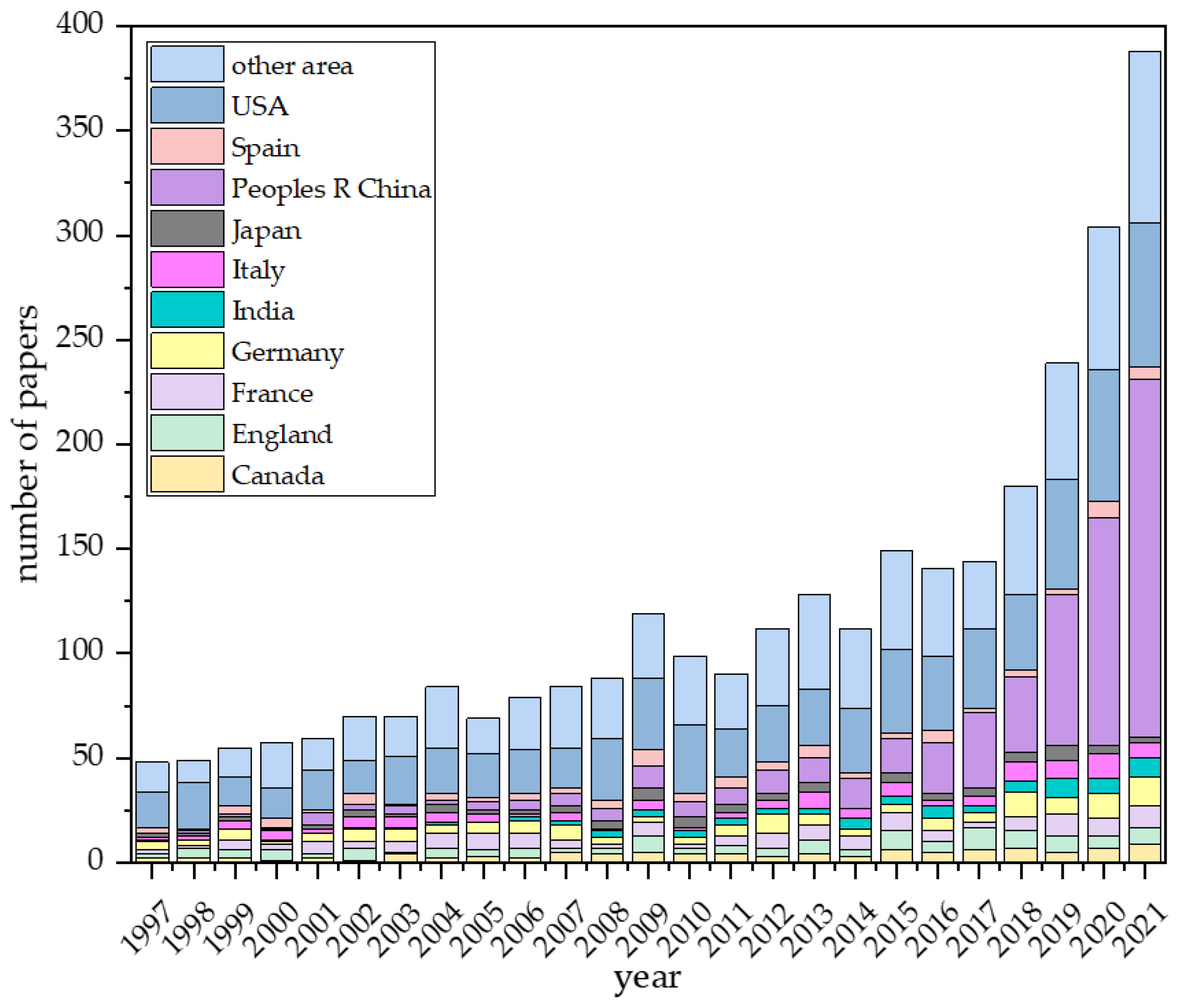




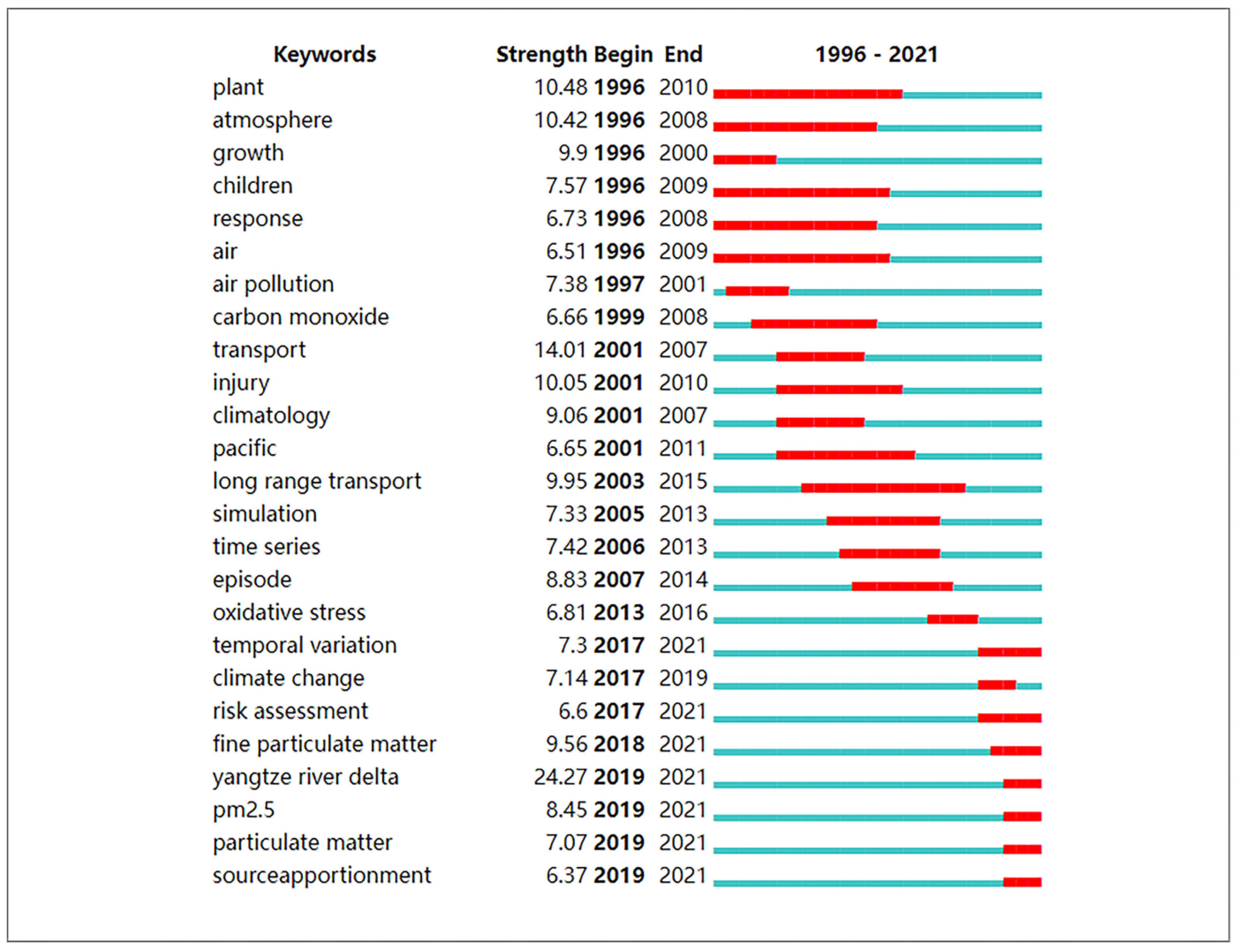
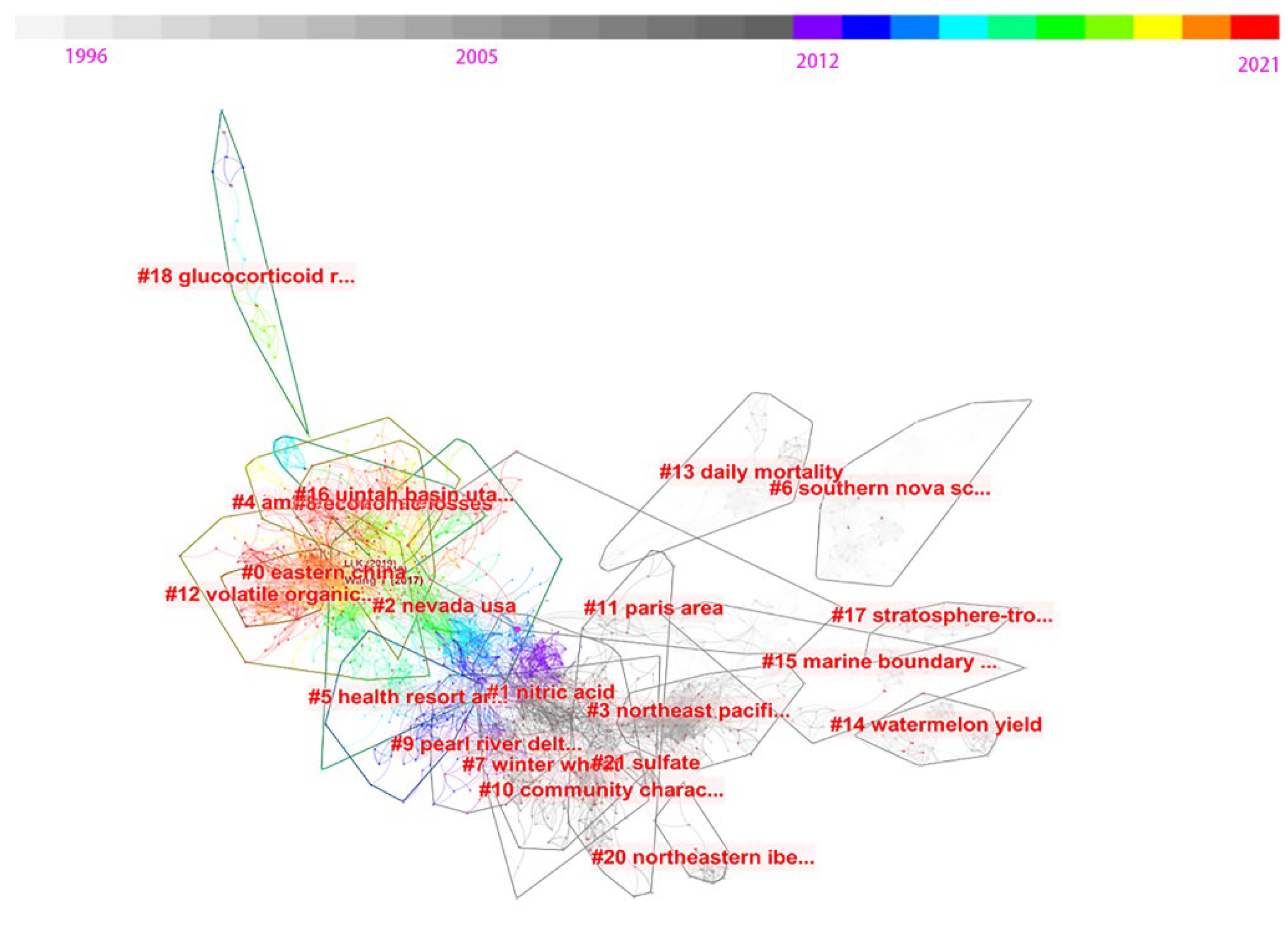
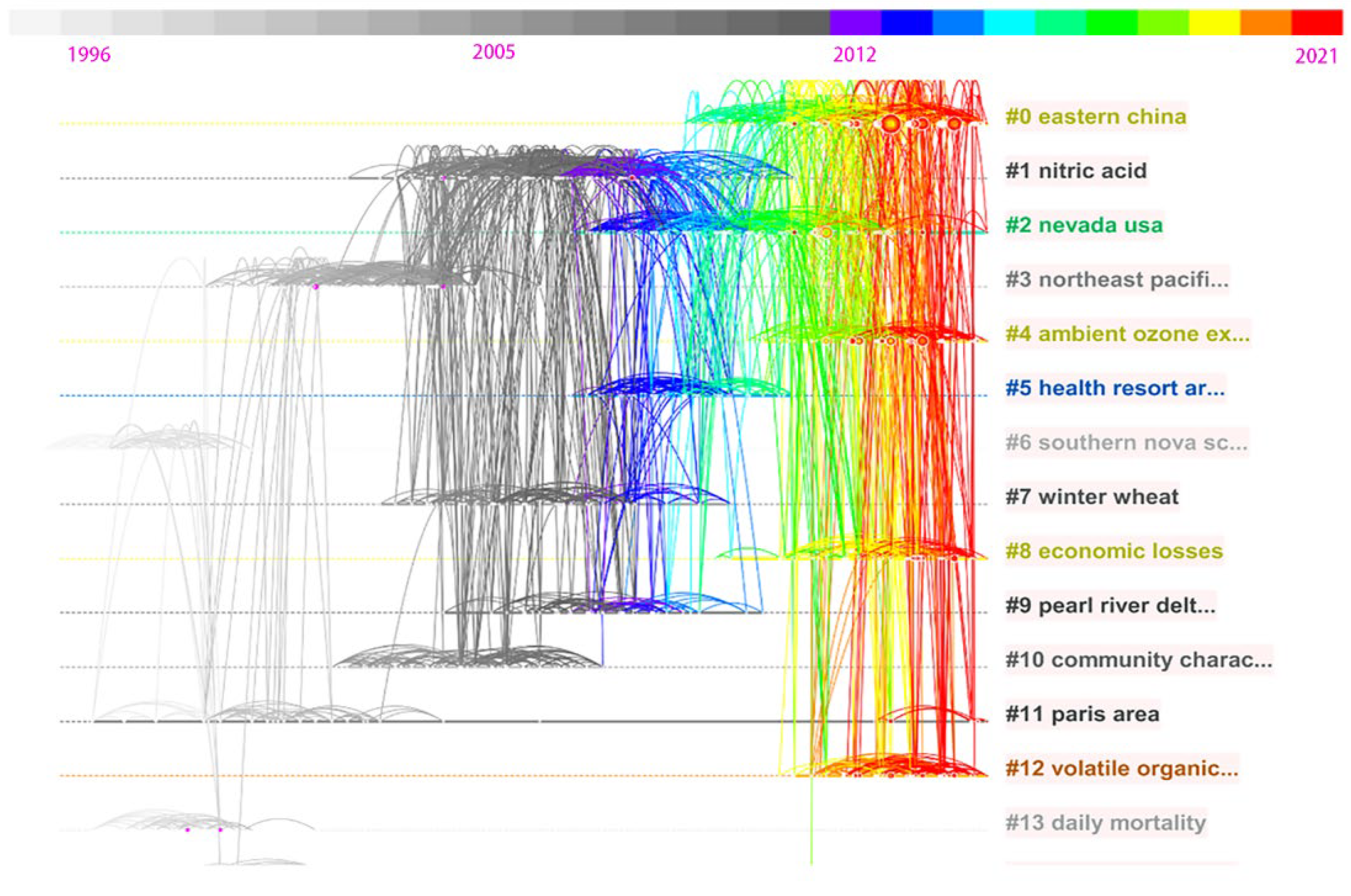
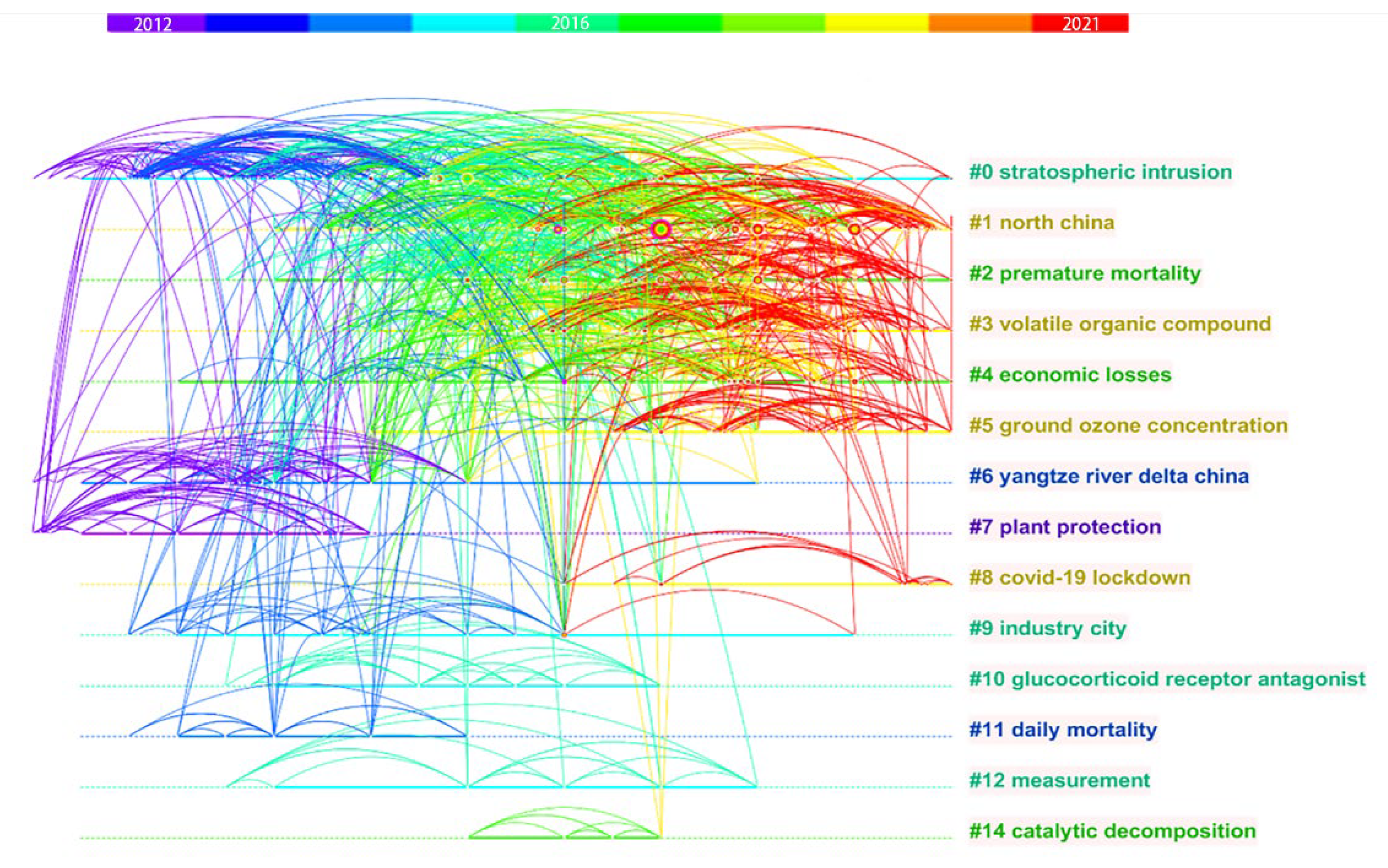

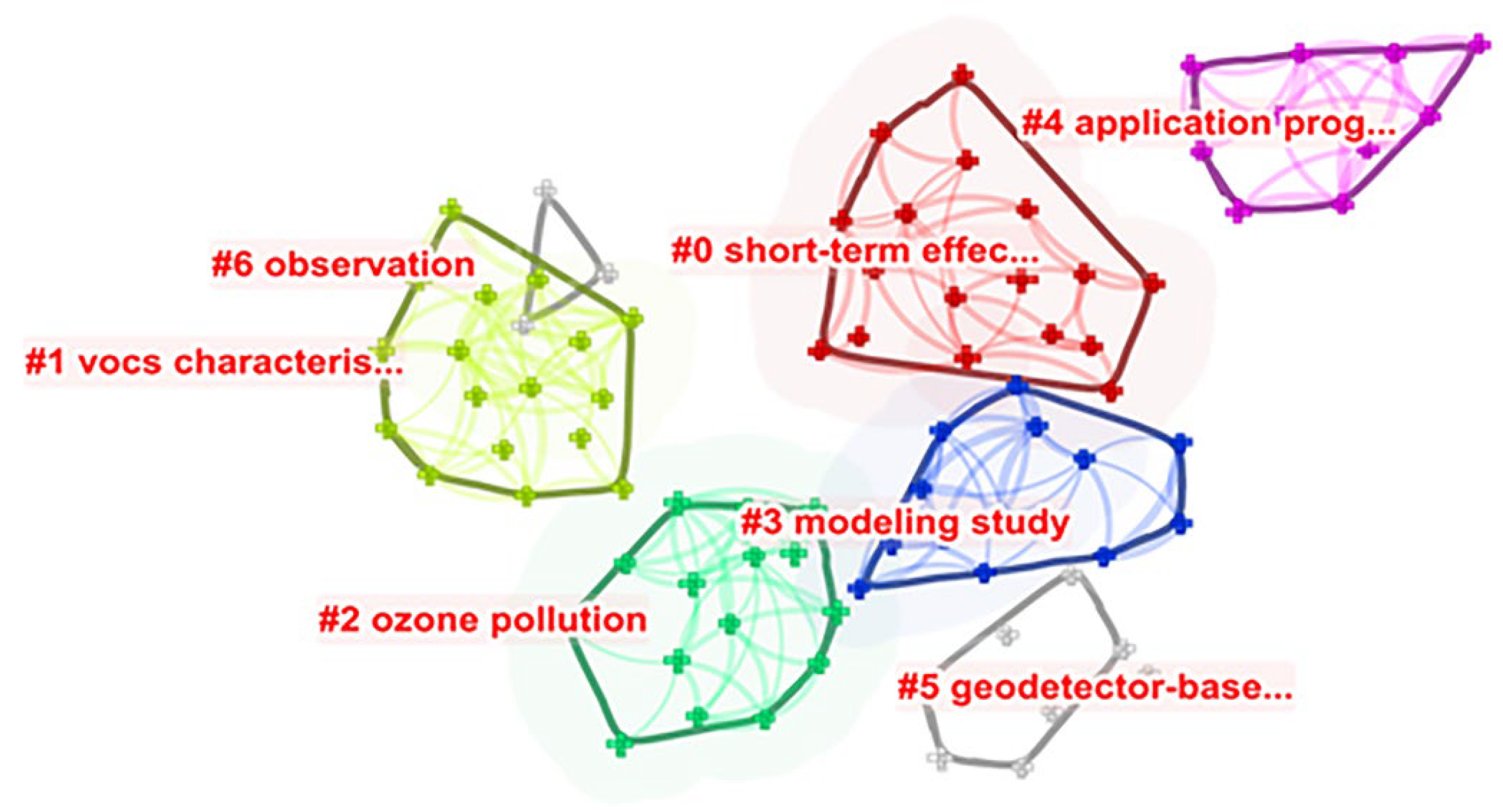
| Ranking | Title | Total Citations | Average per Year | Country | Reference |
|---|---|---|---|---|---|
| 1 | The Ozone Monitoring Instrument. | 1174 | 69.06 | Netherlands, Finland | Levelt, PF et al. (2006) [24] |
| 2 | Long-Term Ozone Exposure and Mortality. | 848 | 607 | USA, Canada | Jerrett, Michael et al. (2009) [25] |
| 3 | Ozone and short-term mortality in 95 US urban communities, 1987–2000 | 792 | 41.68 | USA | Bell, ML et al. (2004) [26] |
| 4 | Inhalation of fine particulate air pollution and ozone causes acute arterial vasoconstriction in healthy adults | 571 | 27.19 | USA, Canada | Brook, RD et al. (2002) [28] |
| 5 | Asthma in exercising children exposed to ozone: a cohort study | 516 | 24.57 | USA | McConnell, R et al. (2002) [29] |
| 6 | Anthropogenic drivers of 2013–2017 trends in summer surface ozone in China | 499 | 124.75 | China, USA | Li, Ke et al. (2019) [27] |
| 7 | An Estimate of the Global Burden of Anthropogenic Ozone and Fine Particulate Matter on Premature Human Mortality Using Atmospheric Modeling | 426 | 32.77 | USA | Anenberg, Susan C. et al. (2010) [30] |
| 8 | A meta-analysis of time-series studies of ozone and mortality with comparison to the national morbidity, mortality, and air pollution study | 414 | 23 | USA | Bell, ML et al. (2005) [31] |
| 9 | Estimating the National Public Health Burden Associated with Exposure to Ambient PM2.5 and Ozone | 360 | 32.73 | USA | Fann, Neal et al. (2012) [32] |
| 10 | Photochemical ozone creation potentials for organic compounds in northwest Europe calculated with a master chemical mechanism | 333 | 13.32 | England | Derwent, RG et al. (1998) [33] |
| Ranking | Keywords | Citation Counts | Keywords | Centrality |
|---|---|---|---|---|
| 1 | Emission | 326 | Exposure | 0.05 |
| 2 | Model | 321 | Chemistry | 0.05 |
| 3 | Impact | 310 | Pollutant | 0.05 |
| 4 | Exposure | 289 | Trend | 0.04 |
| 5 | Transport | 223 | Boundary layer | 0.04 |
| 6 | Volatile organic compound | 192 | Association | 0.04 |
| 7 | Urban | 190 | Emission | 0.03 |
| 8 | Chemistry | 171 | Model | 0.03 |
| 9 | Climate change | 168 | Impact | 0.03 |
| 10 | Particulate matter | 164 | Transport | 0.03 |
| Cluster ID | Size | Silhouette * | Mean (Year) | Cluster Label (LLR) |
|---|---|---|---|---|
| 0 | 191 | 0.813 | 2016 | Eastern China; Yangtze River delta; source apportionment; Yangtze River delta region; meteorological condition |
| 1 | 188 | 0.81 | 2006 | nitric acid; North America; boreal biomass burning emission; ground-based satellite observation; |
| 2 | 164 | 0.845 | 2012 | Nevada USA; stratospheric intrusion; long-range transport; northern hemisphere; multi-model study |
| 3 | 109 | 0.95 | 2000 | Northeast Pacific; airborne observation; carbon monoxide; Cheeka peak observatory; range-transported pollution |
| 4 | 83 | 0.912 | 2017 | ambient ozone exposure; premature mortality; o-3 exposure; ozone pollution control; Tehran Iran |
| 5 | 77 | 0.927 | 2010 | health resort area; ozone variation; Spanish Sierra; plant protection; Guadarrama mountain range |
| 6 | 76 | 0.973 | 1993 | Southern Nova Scotia; related compound; urban atmosphere; emission control strategies; photochemical indicator |
| 7 | 67 | 0.931 | 2005 | winter wheat; current level; Indian cultivar; food security; metabolite levels growth |
| 8 | 59 | 0.96 | 2016 | economic losses; nitrogen addition; water deficit; elevated ozone; ground-level O-3 |
| 9 | 53 | 0.953 | 2008 | pearl river delta; regional ozone formation; comparative study; process analysis; Northern China |
| 10 | 53 | 0.983 | 2004 | community characteristics; effect modification; morbidity mortality; air pollution study; short-term mortality |
| 11 | 50 | 0.963 | 2004 | Paris area; COVID-19 lockdown; no2 concentration; ground-based observation; temporal change |
| 12 | 45 | 0.953 | 2017 | volatile organic compound; ozone formation; ambient VOCs; central China; pearl river estuary |
| 13 | 44 | 0.997 | 1995 | daily mortality; ambient particulate matter; Montreal Quebec; daily cause-specific mortality; Mexico City |
| 14 | 42 | 0.998 | 1997 | watermelon yield; adverse effect; Eastern Spain; relative sensitivity; different Mediterranean plant species |
| References | Cluster ID | Burst Strength | Begin | End |
|---|---|---|---|---|
| Wang T [37] | 0 | 36.69 | 2018 | 2021 |
| Li K [27] | 0 | 36.59 | 2019 | 2021 |
| Monks PS [10] | 2 | 32.21 | 2015 | 2021 |
| Cooper O R [66] | 2 | 19.34 | 2016 | 2019 |
| Fiore AM [40] | 1 | 19.03 | 2009 | 2014 |
| Bell ML [26] | 10 | 17.02 | 2005 | 2009 |
| Zhang Q [53] | 1 | 16.45 | 2010 | 2014 |
| Liu H [60] | 4 | 16.26 | 2019 | 2021 |
| Cooper OR [65] | 2 | 15.87 | 2011 | 2015 |
| Jacob DJ [45] | 3 | 15.51 | 2001 | 2004 |
| Author [Reference] | Year | Centrality | Themes | Cluster ID |
|---|---|---|---|---|
| POPE CA [67] | 1995 | 0.19 | Air pollution, Health effects | 13 |
| Fiore AM [40] | 2009 | 0.18 | Multiscale models, Intercontinental relationship between the precursor and ozone pollution. | 1 |
| Bascom R [52] | 1996 | 0.16 | Outdoor pollution, Health effects | 13 |
| Horowitz LW [69] | 2003 | 0.12 | A global simulation, Tropospheric ozone | 1 |
| Jacob DJ [45] | 1999 | 0.11 | Asian emissions, Surface ozone in the United States | 3 |
| Duncan BN [46] | 2003 | 0.11 | Biomass burning emissions constrained, Satellite observations | 3 |
| Li QB [68] | 2002 | 0.08 | Stratospheric ozone, Pollution influences on ozone | 3 |
| Zhang Q [38] | 2014 | 0.08 | Surface ozone, Precursors | 0 |
| Parrish DD [43] | 2012 | 0.08 | The long-term variations, Lower stratosphere baseline ozone concentrations | 2 |
| Auvray M [70] | 2005 | 0.08 | The long-range transport, Seasonal variations | 1 |
Publisher’s Note: MDPI stays neutral with regard to jurisdictional claims in published maps and institutional affiliations. |
© 2022 by the authors. Licensee MDPI, Basel, Switzerland. This article is an open access article distributed under the terms and conditions of the Creative Commons Attribution (CC BY) license (https://creativecommons.org/licenses/by/4.0/).
Share and Cite
Hou, Y.; Shen, Z. Research Trends, Hotspots and Frontiers of Ozone Pollution from 1996 to 2021: A Review Based on a Bibliometric Visualization Analysis. Sustainability 2022, 14, 10898. https://doi.org/10.3390/su141710898
Hou Y, Shen Z. Research Trends, Hotspots and Frontiers of Ozone Pollution from 1996 to 2021: A Review Based on a Bibliometric Visualization Analysis. Sustainability. 2022; 14(17):10898. https://doi.org/10.3390/su141710898
Chicago/Turabian StyleHou, Yongjiang, and Zheng Shen. 2022. "Research Trends, Hotspots and Frontiers of Ozone Pollution from 1996 to 2021: A Review Based on a Bibliometric Visualization Analysis" Sustainability 14, no. 17: 10898. https://doi.org/10.3390/su141710898





